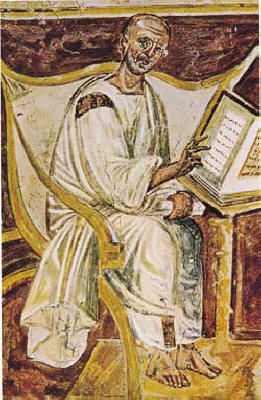St. Augustine: Did You Know . . .
That in the modern sense of the term, Augustine’s Confessions was the first autobiography ever written?
That one of Augustine’s duties as bishop of Hippo was to arbitrate lawsuits?
That Bishop Augustine lived almost entirely on vegetables?
That he encouraged conversation at meals—but with a strictly enforced rule that the character of an absent person should never be negatively discussed? He had a warning to this effect carved on a plaque attached to his table.
That according to his biographer, Possidius, Augustine wrote more than 1,000 total works, including 242 books?
That Augustine set part of his written campaign against the Donatist heresy to verse? Around 394 A.D., Augustine composed a song he titled “An ABC against the Donatists,” and encouraged that it be frequently sung by the orthodox churches in his diocese. It became quite popular.
That at one point early in his career, Augustine was a speechwriter for the Roman emperor?
That a rich pagan man chose the young Augustine to be his protege, in hopes the bright young philosopher would help turn the rapidly Christianizing Roman empire back to paganism?
That while Augustine was still alive, people in France began a movement to canonize his writings and put them on a par with Scripture? And this effort continued for nearly 100 years!
That when Augustine became bishop of Hippo, he was “unalterably fixed there for the rest of his life”? The African church had a rule strictly forbidding the transfer of its bishops.
That Augustine founded a religious order for women, but that all females, even his sister, were excluded from his house and could see him only in the presence of others?
That the pre-Christian Augustine lived with the same woman, out of wedlock, for more than 13 years, and claimed in his writings to have deeply loved her—yet never in his writings reveals her name?
That when the great European universities were formed in the 12th century, the curriculum they used was essentially the same as Augustine had outlined eight centuries earlier in On Christian Doctrine?
The oldest-known portrait of St Augustine
 This picture, taken from a fresco on the wall of the Lateran Palace, is according to Augustine scholars, the oldest-known portrait of the saint—and very likely was based on an image of the saint taken from his very own signet ring.
This picture, taken from a fresco on the wall of the Lateran Palace, is according to Augustine scholars, the oldest-known portrait of the saint—and very likely was based on an image of the saint taken from his very own signet ring.
Incidentally, this portrayal of Augustine bears a striking resemblance to a portrait found in the notebook of the Christian philosopher Boethius, who died in 524 A.D., less than 100 years after Augustine's death.
Both portraits are thought to be taken from a likeness of Augustine prepared for his signet ring. The saint refers to the ring in what is today called Letter 59, wherein he notes the signet, when applied to a seal, "embosses the face of a man turned to the side." Very likely, as this was common custom, the face on the ring was that of the ring owner.
In this image, Augustine is dress in a tunic, mantle, and sandals, thus being depicted as a scholar rather than as a bishop. In his left hand he holdsa scroll; with his right hand be makes an oratorical gesture toward the great book open on the lectern in front of him. The scroll alludes to his own works; the great book to the greatest of books, the Bible.
The Latin inscription at the bottom reads: "The different fathers said different things, but with Roman eloquence this man said all things, thundering forth the sense of the mysteries." The painter did not think it necessary to affix Augustine's names to the painting. The laudatory inscription made it obvious to whom he was referring.
[The above is based on a translation by Father Joseph C. Schnaubelt, O.S.A. of Guiseppe Wilpert's Studi Augustiniani, published in Rome in 1911.]
By the Editors
[Christian History originally published this article in Christian History Issue #15 in 1987]
Next articles
Fighting Isms and Schisms
Augustine battled a succession of “isms” or schisms: first Manichacism, then Donatism, then Pelagiariism.
the EditorsChristian History Timeline: St. Augustine
Chronology of events related to Augustine of Hippo.
the EditorsAugustine’s Sex-Life Change: From Profligate to Celibate
To Carthage then I came Burning burning burning burning . . .
Frank A. James III


